
Dogo Onsen Festival 2026
Bronwyn O'NeillEvery March, Dogo Onsen is dressed up in lanterns and red pinstripes to celebrate its cultural history and provide a platform for the local community to get together.

Dogo Onsen, in central Matsuyama, is one of Japan's oldest hot springs with the main honkan one of the most famous locations at its very center. This wooden public bathhouse dates back to 1894 (Meiji Period) and is said to be one of the inspirations behind film director Hayao Miyazaki's acclaimed Spirited Away anime.
The iconic, 130-year-old main bathhouse at Dogo Onsen reopened fully in July 2024 after a 5.5 year hiatus from renovation and repair work.
The Honkan or Main Building is Dogo Onsen's most famous structure — its picturesque exterior making it the star of photography and Studio Ghibli enthusiasts. One of Japan's oldest hot springs, Dogo Onsen Honkan is designated a National Important Cultural Property and has been renovated several times to preserve as much of its original state as possible. The 3-story structure was designed by Matahachiro Sakamoto, a master craftsman who also played a role in designing Matsuyama Castle. Within the Honkan itself, there are two bathing areas to choose from — Tama no Yu and Kami no Yu.
Constructed in 1953, the Tsubaki no Yu Bathhouse adopts the tsubaki (camellia flower) into its design. The tsubaki flower is a symbol of Matsuyama City. Since its construction and prior remodelling in 1984 and 2017, Tsubaki no Yu has been a local favorite due to its 100% natural hot spring water and charming interior that resembles a kurayashiki (warehouse-office-residence hybrid building).
Unlike the other two bathhouses, Asuka no Yu is a newly constructed building that opened in late 2017. It was named after the architectural style of the Asuka period, which the building was designed to emulate. What makes Asuka no Yu distinct from the Honkan are its open-air baths and private bathing room that was designed to model the Yushinden (the private bath the Imperial Family used at the Honkan).

Every March, Dogo Onsen is dressed up in lanterns and red pinstripes to celebrate its cultural history and provide a platform for the local community to get together.

Dogo Onsen is said to be the model for the bathhouse in the animation “Spirited Away”. It’s the oldest hot spring in Japan, with a history going back over 3,000 years
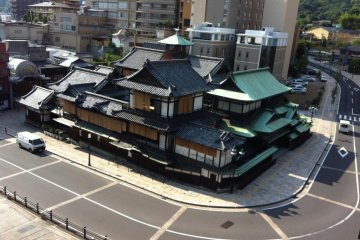
A visit to one of Japan's oldest hot springs, relax and ponder the lives of bathers throughout history at one of the inspirations for anime film Spirited Away

Everybody who visits Matsuyama has a look at Dogo Onsen. But what's it like to go in and take a bath? It's a real experience!

Every March, Dogo Onsen is dressed up in lanterns and red pinstripes to celebrate its cultural history and provide a platform for the local community to get together.
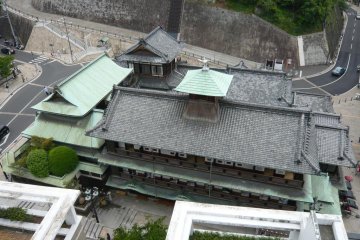
The Hotel Patio Dogo is a modern, comfortable hotel overlooking Dogo Onsen Honkan.

Spa Ryokan Dougoya offers a ryokan-like experience in a stylish 1930s building in Dogo for travelers on a budget.

Spa Ryokan Dougoya offers budget accommodation in Dogo with the atmosphere of a traditional ryokan.
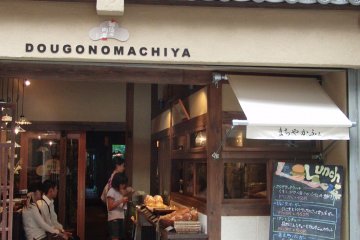
Dogo no Machiya is a beautiful café with courtyard gardens and stylish Japanese décor. It’s ideal for breakfast, lunch, or a relaxing sit.

Dogo's newest addition to the eating, drinking, art scene, Wani to Sai. Located in an atmospheric corner of Dogo, this "circus bar" is a unique underground bar/diner.

The Nikitatsu-An restaurant in Dogo serves reasonably priced Japanese food to accompany the high-quality sake and beer produced in the brewery next door.
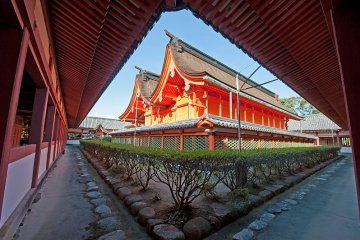
Thought to be at least 1,000 years old, Isaniwa is one of Japan’s three shrines dedicated to the deity Hachiman. After climbing a long stretch of stone stairs, passing a double-story gate, a magnificent bright-red structure emerges. The architectural details are especially grand with the building’s swooping tile roofs, gold-leaf columns and ornate, cloudlike beam engravings. In addition to the spectacular architecture, there are displayed paintings of warriors and warfare (as Hachiman is the guardian of warriors and protector of Japan) and even numerous documents on Japanese mathematics. A hall of treasures features swords and armor for samurai history buffs. Other relics include animal paintings and calligraphy. Supposedly, Isaniwa Shrine originally marked the location where Emperor Chuai and Empress Jingu, who reigned in the third century AD, bathed at one of Japan’s oldest bathhouses, Dogo Onsen, now just a few hundred meters away. The shrine was moved to by the Kono samurai clan in the fourteenth century to the current location where, after conquering the stairs, you can enjoy breathtaking views of Matsuyama city. It was rebuilt in the 17th century by the Matsudaira clan; the current buildings with their great vermilion surface date from 1667. The original imperial bathers are enshrined there. Despite its age, the shrine is still buzzing with worshippers and even couples celebrating or taking pictures for their wedding. Although visitors note that the stairs are a little treacherous, the views and tranquil atmosphere only add to the experience of walking around the colonnade and absorbing a rich and long history—and if you’re lucky, observing a modern-day ceremony. If the trip does tire you out, you can always relax at Dogo Onsen at the foot of the compound.
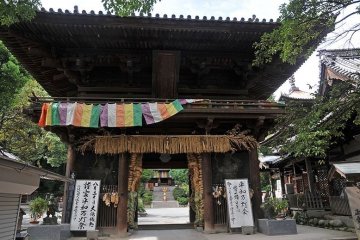
At Matsuyama’s most famous temple, a sight almost as guaranteed as the temple buildings themselves is the cadre of pilgrims in white traveling the Shikoku Pilgrimage, a circular 88-site, 1200-kilometer circuit. Whether you’re at Ishiteji for religious, ascetic or sightseeing reasons, the compound is sprawling and quite unusual. On both sides of Niomon Gate (a National Treasure) are two monumental straw sandals, promising relief for those suffering with painful leg conditions. As you reach the main area, you’ll be greeted by even more curiosities. Stroll through the main hall, itself lined with vibrant panel paintings, enter a cave and you reach yet another temple. This inner structure resembles a large golden bead and contains a famously eclectic collection of sculptures, carvings and paintings. Particularly arresting are the images of the skeletal historic Buddha in the period before his enlightenment. Accompanying these are countless Kannon figures, dwarves, demons and deities. Kobo Daishi, a famous Buddhist monk who supposedly originated the Shikoku Pilgrimage, is immortalized in a towering statue on a nearby forested hill. On top of its treasure-packed halls, a three-story pagoda occupies the main grounds. Ishiteji, which literally means “stone hand temple,” has an origin story as unique as its contents. A man had wronged Kobo Daishi and, wanting to atone, established the path of the Shikoku Pilgrimage in search of the monk. When they finally met, Kobo forgave him and gave him an inscribed stone with which he was buried. Then a boy was born with a stone clenched in his hand; this boy came to build Ishiteji. The legendary stone is still in a small museum on the compound, surrounded by no shortage of similarly precious relics, treasured buildings and, supposedly, people’s souls. If Ishiteji Temple proves to be sensory overload or a tiring trek, historic Dogo Onsen is a few minutes away.

Most might not expect to find a French-style villa below Matsuyama Castle, but this elegant construction offers a respite from the bustling town center of Ehime. Bansuiso, largely hidden by trees and modern buildings, was originally the second Residence of Count Hisamatsu Sadakoto, a descendant of the Matsuyama samurai clan and former lord of the neighboring castle. After living in France and returning with his love of Neo-Renaissance architecture, he commissioned the construction of the villa. Completed in 1922, it was the scene of numerous elite parties and social gatherings, and even welcomed members of the imperial family as guests, including Showa Emperor Hirohito. Bansuiso serves as both a place of art and culture and a sight. The first floor and the basement are freely accessible and for ¥ 300 visitors can climb a wooden staircase to take advantage of more photo opportunities. Although the villa hosts solo exhibitions, it also has its own murals and portraits, including the portrait of the first owner.